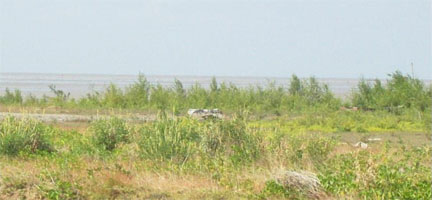We wish to clarify a lot of the points in your front page article written by Alva Solomon on Monday, January 25, 2010, captioned ‘Residents dispute mangrove replant “success.”’

As your readers may know, the Government of Guyana recognises that the high cost of repairing sea defence structures in a critical condition is unsustainable and they have to urgently seek more cost effective ways of protecting the coastline. As part of this programme, in January 2009, the ministry undertook trial plantings at Mon Repos and at Ann’s Grove to test the possibility of re-establishing mangrove belts which in the past protected large parts of the shoreline as well as providing a habitat for bees, crabs and young fish fingerlings.
The planting at Mon Repos was relatively successful, see attached photograph, but the other one failed for a variety of reasons.
You are quite correct to raise the issue of the monitoring of mangroves in your newspaper, for the Sea and River Defences Division has been hampered for some time, by a lack of rangers to patrol the foreshore. The government is, however, aware of the situation and is in the process of recruiting an additional fifteen persons to assist with this task. In fact the job of ranger is to be upgraded so that they have the necessary legal support and training to prevent damage to our valuable foreshore resources.
Damage by animals to sea defence structures takes many forms, from erosion of the clay banks behind the rip rap structures to, in the case of goats, the nibbling away of mangrove plants on the foreshore. However, we have visited the site photographed in your newspaper article and would like to point out that the cows have been very selective in what they ate! They left the mangroves alone and concentrated on the more succulent grass which surrounds them.
As many of your readers will know, the European Union has been a key partner with the Government of Guyana in the repair and rehabilitation of sea defences. However, it has been recognised by both parties that the high cost of repairing sea defences is unsustainable and alternative, cheaper means of protecting the foreshore must be sought.
With this in mind, the government and the European Union are currently preparing a project which will cost some €4.165 million. This will assist the government in its attempts to find cheaper and more sustainable means of protecting the foreshore. Mangroves can also provide benefits in terms of carbon sequestration, fixing about half the amount per annum of tropical rain forests. So yes, there is an important role as well to be played in terms of the Low Carbon Development Strategy.
The contribution of Charles Sohan is welcome, and illustrates the importance, not only of close monitoring of rehabilitated areas, but also the need for effective community involvement in those programmes accompanied by a successful public awareness campaign. These will be important elements of the new Climate Change Project to be funded by both the Government of Guyana and the European Union. Further announcements on the new project will be forthcoming in the coming weeks, and we would like your readers to know that at the National Agricultural Research Institute a dedicated team is working to prepare the details of the new programme, which will be announced in the coming weeks.
The team has already acknowledged that there is a significant body of knowledge on mangrove regeneration within Guyana, albeit fragmented at the present time, and that there are many key stakeholders which must be involved if the new programme is to be successful. These include not only Sea Defences, but the Guyana Forestry Commission, the National Drainage and Irrigation Authority, the Fisheries Department, the Environmental Protection Agency, the private sector and non-governmental organisations.
However, most encouraging of all, has been the response of communities along the coastline. In particular, we would like to mention the very positive response we have received from members of the fishing/boat building community at Mon Repos. They are very keen to participate in, and see the new programme succeed. So we hope that in future weeks, we can keep your readers fully informed of the new programme and the progress we intend to make.
Yours faithfully,
Agnes Dalrymple
Chief Sea and
River Defence Officer (ag)





